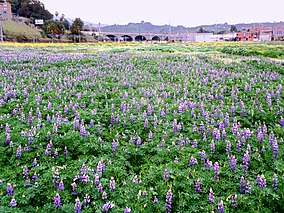Los Angeles State Historic Park
Los Angeles State Historic Park (LASHP) is a California State Park within the Chinatown neighborhood of Los Angeles. Also known as the Cornfield, the former brownfield consists of a long open space between Spring Street and the tracks of the Metro Gold Line.[1] Located outside the main commercial and residential area in the northeast portion of Chinatown, the area is adjacent and southeast of the Elysian Park neighborhood.
| Los Angeles State Historic Park | |
|---|---|
 A view of Los Angeles State Historic Park | |
  | |
| Location | Los Angeles County, California |
| Nearest city | Los Angeles, California |
| Coordinates | 34°3′58″N 118°14′4″W |
| Area | 32 acres (13 ha) |
| Established | 2001 |
| Governing body | California Department of Parks and Recreation |
History
This former site of the Southern Pacific Transportation Company's River Station (1876−1901) is considered the "Ellis Island of Los Angeles" where new arrivals from the east first disembarked.[2][3][4] Corn leaking from train cars and sprouting along the tracks gave rise to the nickname The Cornfield.[3] The 32-acre (13 ha) site was established as a California state park in 2001.[5]
Park development
In 2001, a five-foot section of the historical Zanja Madre irrigation canal was uncovered.[1] In 2005, the former industrial site was transformed into a productive cornfield for one season as an art project called "Not a Cornfield."[6]
In 2006, a contest was held in conjunction with the California State Parks Foundation to select a design for the park.[7] The preliminary park opened on September 23 of the same year.[8] Hargreaves and Associates of San Francisco ultimately won the contest.[9]
Development of the park has been slow.[10] California's budget deficit forced officials to scale back plans for the park in 2010, earmarking $18 million instead of the planned $55 million. Plans for a bridge, water fountain, theme gardens, an upscale restaurant, as well as an ecology center with restored wetlands were tabled. The tabled features may be added later if funding becomes available.[3] As of 2018, the park is now open; the campfire circle, restrooms and parking lot are available for public use.
Numerous community fairs and gatherings have been held in the park. It also contains several plaques that relate the history of the Cornfield, Chinatown and Downtown Los Angeles.
See also
References
- Rasmussen, Cecilia (2003-07-13). "Pasadena's Gold Line will travel a history-laden route". Los Angeles Times. Retrieved 2012-07-29.
- "Los Angeles SHP". California State Parks. Retrieved 2012-07-29.
- Pool, Bob (2010-12-08). "L.A. State Historic Park plan downsized: State budget deficit prompts more modest project atop old rail yard near downtown". Los Angeles Times.
- Cheng, Sophia (2013). "Community Organizing in Los Angeles Chinatown: Historical Case Study of the Cornfields". Asian American Studies 0100. (Thesis). UCLA.
- "California State Park System Statistical Report: Fiscal Year 2009/10" (PDF). California State Parks: 16. Retrieved 2012-07-29. Cite journal requires
|journal=(help) - Hernandez, Daniel (2005-09-12). "'Not a Cornfield' idea is food for thought". Los Angeles Times. Retrieved 2012-07-29.
- Pool, Bob (2006-07-31). "3 firms are finalists to design park at Cornfield Site in L.A." Los Angeles Times. Retrieved 2012-07-29.
- Lin, Sara (2006-09-24). "'Cornfield' produces park: Hundreds turn out to celebrate the open space where new industrial use had been envisioned". Los Angeles Times. Retrieved 2012-07-29.
- Pool, Bob (2006-11-18). "Planting the seeds of a future park: The state names the winner of the design team that will transform L.A.'s 32-acre Cornfield into a swath of green at the edge of Chinatown". Los Angeles Times. Retrieved 2012-07-29.
- Amter, Charles (2007-10-06). "This park's a little green". Los Angeles Times. Retrieved 2012-07-29.
External links
| Wikimedia Commons has media related to Los Angeles State Historic Park. |
